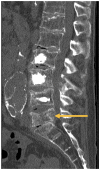Image-guided Percutaneous Polymethylmethacrylate-augmented Spondylodesis for Painful Metastasis in the Veteran Population
- PMID: 31259118
- PMCID: PMC6590854
- DOI: 10.7759/cureus.4509
Image-guided Percutaneous Polymethylmethacrylate-augmented Spondylodesis for Painful Metastasis in the Veteran Population
Abstract
The treatment of painful spinal metastases in patients with limited life-expectancy, significant perioperative risks, and poor bone quality poses a surgical challenge. Recent advances in minimal-access spine surgery allow for the surgical treatment of patients previously considered not to be operative candidates. The addition of fenestrated screws for cement augmentation to existing image-guided percutaneous pedicle screw fixation can enhance efficiency, decrease risk of hardware complications, and improve back pain in this patient population. The patient is a 70-year-old man with severe axial back pain due to metastatic prostate cancer and L5 pathologic fractures not amenable to kyphoplasty. In the setting of a 6-12-month life-expectancy, the primary goal of surgery was relief of back pain associated with instability with minimal operative morbidity and post-operative recovery time. This was achieved with an internal fixation construct including percutaneously placed cement-augmented fenestrated pedicle screws at L4 and S1. The patient was discharged to home on post-operative day 1 with substantial improvement of his low back pain. Image-guided, percutaneous placement of fenestrated, cement-augmented pedicle screws is an emerging treatment for back pain associated with metastasis. Fenestrated screws allow for integrated cement augmentation. The minimal associated blood loss and recovery time make this approach an option even for patients with limited life-expectancy. This is the first report of utilization of this technique for the veteran population.
Keywords: cement-augmentation; minimal access spine surgery; polymethylmethacrylate; spinal metastases; spondylodesis.
Conflict of interest statement
The authors have declared that no competing interests exist.
Figures



Similar articles
-
Technical Note: Pedicle Cement Augmentation with Proximal Screw Toggle and Loosening.Orthop Surg. 2019 Jun;11(3):510-515. doi: 10.1111/os.12467. Epub 2019 Jun 9. Orthop Surg. 2019. PMID: 31179643 Free PMC article.
-
Utility of Cement Augmentation via Percutaneous Fenestrated Pedicle Screws for Stabilization of Cancer-Related Spinal Instability.Oper Neurosurg. 2019 May 1;16(5):593-599. doi: 10.1093/ons/opy186. Oper Neurosurg. 2019. PMID: 30508168 Free PMC article.
-
Effect of augmentation techniques on the failure of pedicle screws under cranio-caudal cyclic loading.Eur Spine J. 2017 Jan;26(1):181-188. doi: 10.1007/s00586-015-3904-3. Epub 2015 Mar 27. Eur Spine J. 2017. PMID: 25813011
-
Polymethylmethacrylate-augmented fenestreted pedicle-screw fixation in low bone quality patients: a case series and literature review.J Biol Regul Homeost Agents. 2018 Nov-Dec;32(6 Suppl. 1):71-76. J Biol Regul Homeost Agents. 2018. PMID: 30644285 Review.
-
Minimally invasive surgery for femoral neck fractures using bone cement infusible hollow-perforated screw in high-risk patients with advanced cancer.Surg Oncol. 2015 Sep;24(3):226-31. doi: 10.1016/j.suronc.2015.05.003. Epub 2015 May 22. Surg Oncol. 2015. PMID: 26051408 Review.
Cited by
-
Comparing the efficacy and safety of cement-augmented fenestrated pedicle screws and conventional pedicle screw in surgery for spinal metastases: a retrospective comparative cohort study.Transl Cancer Res. 2022 Dec;11(12):4397-4408. doi: 10.21037/tcr-22-2631. Transl Cancer Res. 2022. PMID: 36644174 Free PMC article.
References
-
- Metastatic spinal cord compression. Occurrence, symptoms, clinical presentations and prognosis in 398 patients with spinal cord compression. Bach F, Larsen BH, Rohde K, et al. Acta Neurochir. Wien;107:37–43. - PubMed
-
- Experiences with metastatic neoplasms involving the spinal cord. Barron KD, Hirano A, Araki S, Terry RD. Neurology. 1959;9:91–106. - PubMed
-
- Epidural metastases in prospectively evaluated veterans with cancer and back pain. Ruff RL, Lanska DJ. https://www.ncbi.nlm.nih.gov/pubmed/2524249. Cancer. 1989;63:2234–2241. - PubMed
Publication types
LinkOut - more resources
Full Text Sources
